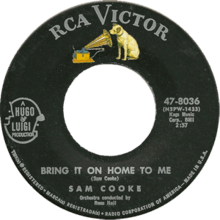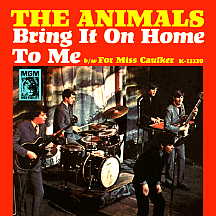Bring It On Home to Me
| "Bring It on Home to Me" | ||||
|---|---|---|---|---|
 | ||||
| Single by Sam Cooke | ||||
| A-side | "Having a Party" | |||
| Released | May 8, 1962 | |||
| Format | 7" | |||
| Recorded |
April 26, 1962 RCA Studio 1 (Hollywood, California) | |||
| Genre | Rhythm and blues, soul | |||
| Length | 2:37 | |||
| Label | RCA Victor | |||
| Writer(s) | Sam Cooke | |||
| Producer(s) | Hugo & Luigi | |||
| Sam Cooke singles chronology | ||||
| ||||
"Bring It on Home to Me" is a song by American soul singer Sam Cooke, released on May 8, 1962 by RCA Victor. Produced by Hugo & Luigi and arranged and conducted by René Hall, the song was the B-side to "Having a Party". The song peaked at number two on Billboard's Hot R&B Sides chart, and also charted at number 13 on the Billboard Hot 100.
The song has become a pop standard, covered by numerous artists of different genres. It is one of The Rock and Roll Hall of Fame's 500 Songs that Shaped Rock and Roll.
Background
"Bring It on Home to Me", like its A-side, "Having a Party", was written while Cooke was on tour for Henry Wynn. The song was initially offered to fellow singer Dee Clark, who turned it down.[1] While in Atlanta, Cooke called co-producer Luigi Creatore and pitched both numbers; he was sold and booked an immediate recording session in Los Angeles scheduled for two weeks later.[2] The session's mood "matched the title" of the song, according to biographer Peter Guralnick, as many friends had been invited. "It was a very happy session," recalled engineer Al Schmitt. "Everybody was just having a ball. We were getting people out there [on the floor], and some of the outtakes were hilarious, there was so much ad lib that went on."[2] René Hall assembled an eighteen-piece backing group, "composed of six violins, two violas, two cellos, and a sax, plus a seven-piece rhythm section that included two percussionists, two bassists, two guitars, and a piano."
The song is a significant reworking of Charles Brown's 1959 single "I Want to Go Home", and it retains the gospel flavor and call-and-response format; the song differs significantly in that its refrain ("Bring it to me, bring your sweet lovin', bring it on home to me") is overtly secular.[2] The song was the first serious nod to his gospel roots ("[He] felt that he needed more weight, that that light shit wouldn't sustain him," said J.W. Alexander).[1] The song was aiming for a sound similar to Cooke’s former group, the Soul Stirrers.[2] The original, unreleased first take includes vocals from Lou Rawls, J.W. Alexander, Fred Smith (former assistant A&R rep at Keen Records), and "probably" the Sims Twins. A second, final take leaves Lou Rawls as the only echoing voice.[2]
Personnel
"Bring It On Home to Me" was recorded on April 26, 1962, at RCA Studio 1 in Hollywood, California.[1] The engineer present was Al Schmitt, and the session was conducted and arranged by René Hall. The musicians also recorded "Having a Party" the same day. Credits adapted from the liner notes to the 2003 compilation Portrait of a Legend: 1951–1964.[1]
|
Cover versions
| "Bring It On Home to Me" | ||||
|---|---|---|---|---|
 | ||||
| Single by The Animals | ||||
| from the album Animal Tracks (U.S. album) | ||||
| B-side | "For Miss Caulker" | |||
| Released | March 1965 | |||
| Format | 7" single | |||
| Recorded | March 1965 | |||
| Genre | Rock, blues, pop, soul | |||
| Length | 2:43 | |||
| Label | Columbia | |||
| Writer(s) | Sam Cooke | |||
| Producer(s) | Mickie Most | |||
| The Animals singles chronology | ||||
| ||||
| "Bring It on Home to Me" | ||||
|---|---|---|---|---|
| Single by Mickey Gilley | ||||
| B-side | "How's My Ex Treating You" | |||
| Released | June 1976 | |||
| Format | 7" | |||
| Recorded | May 1976 | |||
| Genre | Country | |||
| Label | Playboy Records 6075 | |||
| Writer(s) | Sam Cooke | |||
| Producer(s) | Eddie Kilroy | |||
| Mickey Gilley singles chronology | ||||
| ||||
The most significant cover versions of the song include versions by:
- The Animals (their last single to include original organist Alan Price).
- Mickey Gilley hit number one on the country chart in 1976 with his cover.[3]
- In the United Kingdom, Rod Stewart released this song as part of a medley with "You Send Me" and charted it on the UK Singles Chart at #7 as a double A-side with "Farewell".
- Rita MacNeil covered the song on her 1992 album Thinking of You. It was released as the album's first single and charted on the RPM pop and country charts.
Charts and certifications
Original version
| Chart (1962) | Peak position |
|---|---|
| US Billboard Hot 100[4] | 13 |
| US Hot R&B Sides (Billboard)[4] | 2 |
The Animals version
| Year | Chart | Position |
|---|---|---|
| 1965 | Pop Singles Chart | #32 |
| 1965 | UK Singles Chart | #7 |
| 1965 | Canada | #7 |
| 1965 | Netherlands | #3 |
| 1965 | Sweden | #1 |
Eddie Floyd version
| Year | Chart | Position |
|---|---|---|
| 1968 | Black Singles Chart | #4 |
| 1968 | Pop Singles Chart | #17 |
| 1968 | Canada | #24 |
Lou Rawls version
| Year | Chart | Position |
|---|---|---|
| 1970 | Black Singles Chart | #45 |
| 1970 | Pop Singles Chart | #96 |
Mickey Gilley version
| Chart (1976) | Peak position |
|---|---|
| U.S. Billboard Hot Country Singles | 1 |
| U.S. Billboard Bubbling Under Hot 100 | 1 |
| Canadian RPM Country Tracks | 1 |
| Preceded by "Say It Again" by Don Williams |
Billboard Hot Country Singles number-one single August 21, 1976 |
Succeeded by "(I'm A) Stand by My Woman Man" by Ronnie Milsap |
| Preceded by "Rocky Mountain Music" by Eddie Rabbitt |
RPM Country Tracks number-one single September 11, 1976 |
References
- 1 2 3 4 Portrait of a Legend: 1951–1964 (liner notes). Sam Cooke. US: ABKCO Records. 2003. 92642.
- 1 2 3 4 5 Guralnick, Peter (2005). Dream Boogie: The Triumph of Sam Cooke. New York: Back Bay Books, p. 404–406. First edition, 2005.
- ↑ Whitburn, Joel (2004). The Billboard Book Of Top 40 Country Hits: 1944-2006, Second edition. Record Research. p. 136.
- 1 2 "Sam Cooke – Awards". AllMusic. Retrieved February 28, 2014.